Progress report for LNC21-450
Project Information
The Nebraska Sandhills region is one of the largest (20,179 miles2), intact native grasslands remaining in the world. Sandhills grasslands are used primarily for beef cattle production, but these native environments also provide important wildlife and plant species habitat, wetlands and water infiltration for recharge of the Great Plains aquifer, and other ecosystem services such as recreation. Vegetation management typically includes a combination of grazing strategies, mechanical and chemical control of invasive plants, and, less frequently, prescribed fire. Tradeoffs that occur among competing ecosystem services (e.g., soil health, cattle weight gain, economic return, wildlife diversity) and disservices (e.g., invasive species, low plant diversity, compromised soils) must be evaluated and quantified when making management decisions that have consequences for sustaining livelihoods.
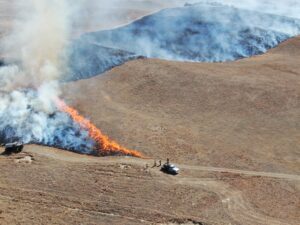
The collaborative adaptive management (CAM) project at Barta Brothers Ranch began its research by evaluating alternative, stakeholder-designed approaches to grassland management in the Sandhills and surrounding north-central Great Plains. Preliminary meetings with the CAM Project Team (ranchers, land managers, researchers) broadly identified management of invasive species, enhancing livestock performance, and managing for multifunctionality, or managing for multiple ecosystem services on the same land area, as key uncertainties and primary goals for the research. A patch-burn grazing system was recommended as a management practice that could address these areas of concern.
Utilizing the adaptive management framework, researchers established protocols to monitor changes in livestock performance, landscape and species heterogeneity, and forage productivity before, during, and after the grazing season. In the springs of 2022 & 2023, through cooperation among stakeholders in the region, Barta Brothers Ranch completed a prescribed burn in one, 160-acre pasture in the four-pasture system. Based on initial observations in forage recovery, an addendum was adopted to allow cattle to openly graze all four pastures in the system (i.e., season-long continuous grazing).
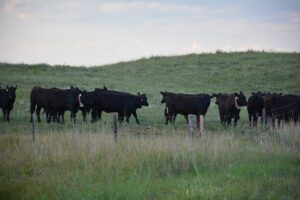
Animals (spayed heifers) were put out to pasture in mid-May and removed in mid-September. Stocking rates (.62 AUMs/acre) reflected real-world conditions and were held constant throughout the grazing season despite an ongoing regional drought. As a control, a similarly stocked four-pasture deferred system was also established at Barta Brothers Ranch. Animals were weighed three times during the grazing season with some heifers (n=8) tracked via GPS collars.
During the sampling period, researchers also monitored: landscape cover change via geospatial monitoring and remote sensing, livestock behavior and performance, annual plant production, erosion, grassland bird diversity, and the social learning among members of the CAM project team.
Quarterly meetings along with phone and email communication took place throughout each growing season. This active engagement among stakeholders is foundational to the CAM approach. Through the co-production of science, shared learning and trust are fostered among the participants in the CAM research project at Barta Brothers Ranch.
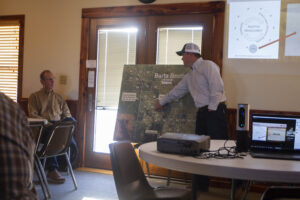
CAM requires stakeholder involvement from inception to completion. We will: 1) Establish a CAM program in the Sandhills to identify management challenges and goals; 2) Establish Barta Brothers Ranch (BBR), a University-owned ranch, as a location for “learning-by-management” experiments, where stakeholders voice and test management hypotheses in an environment that does not affect their livelihoods; 3) Compare alternative, stakeholder-identified approaches and evaluate their effects; 4) Develop monitoring and tradeoff tools for assessing tradeoffs among alternative management approaches and informing decisions that affect the attainment of economic and environmental goals; and 5) Evaluate progress, success and uptake of the CAM for rangelands.
In 2020, the University of Nebraska’s Barta Brothers Ranch launched a collaborative adaptive management (CAM) project to address risks and uncertainties related to grassland management in the Sandhills. This project focuses on evaluating stakeholder-designed management plans in a collaborative research setting. This emphasis on co-producing science ensures CAM reflects real-world ranching conditions of the Sandhills and the north-central Great Plains. This publication highlights preliminary results from years 1 and 2 of the study (2022, 2023 grazing seasons).
Cooperators
Research
Patch-burn grazing systems can increase livestock performance and rancher profitability while minimizing tradeoffs to other desired functions of the landscape.
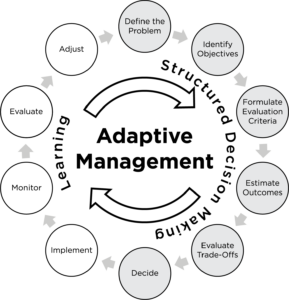
Adaptive Management Framework
The foundation of the CAM Project at Barta Brothers Ranch comes from its linkage to the adaptive management framework. Adaptive management is an iterative process with aims to increase understanding of a system through a structured decision-making process. This includes: 1) defining the problem, 2) identifying objectives, 3) formulating evaluation criteria, estimating outcomes, 4) evaluating trade-offs, 5) decide on actions to be taken, 6) implement action plan, 7) monitor system behavior, 8) evaluate management outcomes, 9) adjust management.
Monitoring
The CAM Project Team will continue to refine what and how to monitor, and to develop expectations of responses to stakeholder-implemented management. Since the project began in 2022, CAM members have voted to maintain data collection as stated below. However, an additional question regarding return interval rates of eastern redcedar after various treatment effects was proposed and is under development as a potential dissertation topic.
Vegetation
1: Vegetation data will be collected each year, including the year prior to application of treatments. Plant community species composition and dry weight rank will be assessed using a 40 by 40 cm monitoring frame placed at multiple locations within the study areas at each CAM project. Trained technicians will locate multiple monitoring points based on ecological site, topography, and aspect. Technicians will record all rooted plant species within each monitoring frame placement. These data will provide species richness, species frequency of occurrence and diversity, spatial variability of plant groupings, and relative importance of species across the locations and management alternatives. Multiple grazing exclosures will be placed throughout the study pastures and annual net primary plant production will be collected at peak standing crop during the growing season by clipping all plant material at ground level, separating by functional plant group, drying to a consistent weight, and recording weights.
2. Remotely-Sensed Monitoring Data: at broader scales, remote sensing technology will be utilized to evaluate ground cover, tree cover, shrub cover, perennial forb and grass cover and biomass (i.e., productivity), and annual forb and grass cover and biomass using the Rangeland Analysis Platform (rangelands.app). Percent cover values are available in an online user interface, for download, and on Google Earth Engine (Gorelick et al. 2017) annually at 30-meter grain, whereas biomass is available annually or over 16-day intervals at 30-meter grain. Additional remote sensing products for early identification and tracking of vegetation state-transitions at multiple scales (state-transition screening, Uden et al. 2019, www.rangelands.app) will supplement monitoring of vegetation cover and biomass. These metrics will be used to evaluate changes in functional group ground cover and biomass continuously across the ranch. Additionally, data from airplane imagery will be incorporated into the baseline data to explain the available resource and track departures based on management strategies.
Grassland birds
Each experimental unit or pasture will have 24 plots laid out in a grid with sampling points spaced 250 m apart. To measure songbird abundance and composition, we will conduct 150-m fixed-radius point counts 3 times at each point in each year. At each point, an observer will record all birds seen or heard for 6 minutes and the estimated distance from the observer to the bird. Species, sex, and behavior (observed singing, observed calling, heard singing, heard calling, observed only) of the bird will be recorded.
Livestock production and grazing behavior
Livestock production metrics will be calculated by beginning (prior to turn out on study pastures) and end (conclusion of the grazing period) weights of cows, calves, and/or yearling cattle. We will also measure differences in reproductive success of the cattle groups under different management practices. Additionally, GPS tracking collars will be placed on a portion of the study animals to evaluate shifts in cattle grazing behavior (i.e., grazing and resting times) and grazing distribution (i.e., where animals are grazing) in the study pastures.
Soil erosion
To monitor this effect, pins are driven into the ground in a grid (n=38) in a burned and unburned/control pasture. Initial depths are recorded and periodically remeasured throughout the grazing season. The difference in these measurements is the amount of erosion or deposition that had occurred at that pin location.
Soil health
Soil samples will be collected to arrive at estimations of patterns of nutrient return in relation to management practices and the influence on soil N, C, and P. Soil samples on the zones generated from the mapping at the treatment sites will be collected during late March. We anticipate taking soil samples from a maximum of three pastures in each treatment area. In each pasture, 30 soil samples from 0-20 cm depth will be collected at fixed intervals in a 100-m transect. Samples of each transect will be air dried and analyzed for available P (Mehlich III), soil organic matter (loss on ignition), total N, ammonium, and nitrate. Potential N mineralization will be determined using a short term (14 days) aerobic incubation with destructive sampling made 1, 3, 5, 7, and 14 days to measure nitrate and ammonium.
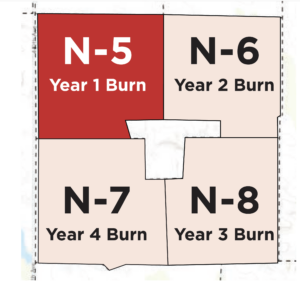
Despite challenging fire weather and drought conditions each spring, the first two years of the CAM project were implemented successfully. Each year, a quarter section of pasture was burned followed by continuous, open grazing of yearling spayed heifers. In 2022, pasture N-5 was burned followed by pasture N-6 in 2023. Heifers were stocked at similar rates (.6 AUMs/acre) in both years. Researchers targeted livestock behavior, landscape heterogeneity and species diversity (e.g., spatial composition of vegetation and richness of birds), and livestock performance (e.g., weight gain) for evaluation. Below are preliminary results from years 1 and 2 of the study, along with discussions of the research.
Annual plant production
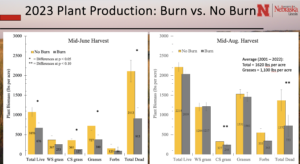 If prescribed fire is to be used in grazing management systems, a deeper understanding of how vegetation productivity is affected by fire is paramount. In 2022 & 2023, plant samples were collected in the burned pastures and compared to BBR’s long-term grazing systems data, which has evaluated plant biomass production at the ranch for over 20 years. To date, no differences in the total biomass produced from burned or unburned pastures were found. However, one anticipated difference was detected in the amount of standing dead and litter material. Unsurprisingly, this dry plant matter quickly combusts during a prescribed fire and was significantly lower in burned pastures. In 2023, an additional difference was detected in the production of C3 grasses (cool season). This likely resulted from the timing of the burn, which did not occur until early May as dry and windy conditions persisted throughout the state in March and April. While weather conditions will vary production throughout a given growing season, these two years of data suggest that burning and grazing can occur in the same season with minimal effects on the total plant biomass production.
If prescribed fire is to be used in grazing management systems, a deeper understanding of how vegetation productivity is affected by fire is paramount. In 2022 & 2023, plant samples were collected in the burned pastures and compared to BBR’s long-term grazing systems data, which has evaluated plant biomass production at the ranch for over 20 years. To date, no differences in the total biomass produced from burned or unburned pastures were found. However, one anticipated difference was detected in the amount of standing dead and litter material. Unsurprisingly, this dry plant matter quickly combusts during a prescribed fire and was significantly lower in burned pastures. In 2023, an additional difference was detected in the production of C3 grasses (cool season). This likely resulted from the timing of the burn, which did not occur until early May as dry and windy conditions persisted throughout the state in March and April. While weather conditions will vary production throughout a given growing season, these two years of data suggest that burning and grazing can occur in the same season with minimal effects on the total plant biomass production.
Forage quality
 While total biomass production remained consistent across both burned and unburned pastures at Barta Brothers Ranch, this information does not provide a full picture as to why animals in the burned system have higher average daily gains (ADG) than animals in a traditional four-pasture deferred rotation. To better understand the nutritional quality of plant biomass, a forage quality test was completed in 2023. CAM's working hypothesis, that cattle are attracted to graze nutritious regrowth of grasses and forbs following fire, aligns with previous patch-burn grazing research. CAM's forage analysis of crude protein at Barta Brothers Ranch in June of 2022 (three months post-burn) found crude protein levels to be around 12% in the burned/grazed system. For context, it is suggested that approximately 9% crude protein is required in forage to achieve a 1.0 lb. ADG, at just over 10% the ADG rises to 1.5lbs. However, when sampled again near the end of the 2022 grazing season, there were no differences in crude protein between burned and unburned pastures, with each hovering around 8%.
While total biomass production remained consistent across both burned and unburned pastures at Barta Brothers Ranch, this information does not provide a full picture as to why animals in the burned system have higher average daily gains (ADG) than animals in a traditional four-pasture deferred rotation. To better understand the nutritional quality of plant biomass, a forage quality test was completed in 2023. CAM's working hypothesis, that cattle are attracted to graze nutritious regrowth of grasses and forbs following fire, aligns with previous patch-burn grazing research. CAM's forage analysis of crude protein at Barta Brothers Ranch in June of 2022 (three months post-burn) found crude protein levels to be around 12% in the burned/grazed system. For context, it is suggested that approximately 9% crude protein is required in forage to achieve a 1.0 lb. ADG, at just over 10% the ADG rises to 1.5lbs. However, when sampled again near the end of the 2022 grazing season, there were no differences in crude protein between burned and unburned pastures, with each hovering around 8%.
Livestock behavior
To confirm that animals are attracted to burned areas, GPS tracking collars are placed on 5-8 animals each year to evaluate shifts in cattle grazing behavior (i.e., grazing and resting times) and grazing distribution (i.e., where animals are grazing) in the study pastures. Results from year one aligned with previous patch-burn grazing research, suggesting cattle are attracted to the flushes of new growth. For example, in 2022 cattle in the patch burn system were 1.5 – 2.0x as likely to occupy burned patches compared to the unburned patches. This pattern did not hold in 2023 (see figure 5), which was likely a result of the timing of the prescribed burn.
Livestock performance
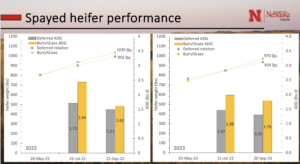 Spayed yearling heifers were weighed three times during the year, pre-turnout in May, mid-season in July, and at pull-off in late September. As a control, heifers in the burned/grazed pastures (pastures N-5 through N-8) were compared to other spayed heifers stocked at a similar rate in a standard four-pasture deferred rotation on the ranch. At the end of the grazing season in 2022, cattle in the burn/graze system were 43 lbs. heavier than those in the standard deferred system. In 2023, the gains averaged about 36 lbs. higher. In both years, these gains were not consistent throughout the season. In 2022, the cattle tended to gain more weight in June and July but later tracked closely with gains of the animals in the standard deferred rotation. In 2023, average daily gains held throughout the growing season. The last two years have seen high-price cattle scenarios, and burned/grazed cattle yielded $86.96 more per head in 2022 and $138.98 per head in 2023.
Spayed yearling heifers were weighed three times during the year, pre-turnout in May, mid-season in July, and at pull-off in late September. As a control, heifers in the burned/grazed pastures (pastures N-5 through N-8) were compared to other spayed heifers stocked at a similar rate in a standard four-pasture deferred rotation on the ranch. At the end of the grazing season in 2022, cattle in the burn/graze system were 43 lbs. heavier than those in the standard deferred system. In 2023, the gains averaged about 36 lbs. higher. In both years, these gains were not consistent throughout the season. In 2022, the cattle tended to gain more weight in June and July but later tracked closely with gains of the animals in the standard deferred rotation. In 2023, average daily gains held throughout the growing season. The last two years have seen high-price cattle scenarios, and burned/grazed cattle yielded $86.96 more per head in 2022 and $138.98 per head in 2023.
Soil erosion
Originally formed by windblown sands, soils, and dust, Nebraska’s Sandhills are vulnerable to erosion by their very design. A key stakeholder concern is that by using prescribed fire, an unacceptable amount of risk is created if high winds or dry conditions trigger dune shifts. To monitor this effect, erosion measurements were taken at both burned and unburned pastures before and after the grazing season. On average, the burned/grazed pastures lost .881 cm of soil while the unburned/grazed lost .631 cm. While there was technically more erosion in the burned pasture, these amounts are negligible. This finding aligns with previous research performed in the Sandhills that found 4-5 years of repeated vegetation suppression was required before significant movement of soil occurred.
Soil health
In grassland systems, plant productivity is highly dependent on the availability of nutrients in the soil’s profile. To further document the effects of utilizing prescribed fire, periodic measurements of soil properties such as organic matter, pH, and soil nutrient levels were taken before and after prescribed burning, followed then by monthly sampling through the remainder of the grazing season. These results showed no significant long-term changes in pH levels among burned and unburned pastures; however, there was an expected increase in both pastures one month after the burn (attributed to ash deposition in the pastures). No significant changes in soil organic matter nor any significant biological changes in the soil’s ability to exchange nutrients were detected. Of the major nutrients sampled, nitrate, potassium, and sodium had significant increases following the burn. However, as grazing was introduced, these levels ultimately returned to levels found in the adjacent unburned pastures. These results help support the notion that low-intensity prescribed burning can occur without irrevocably altering the soil’s organic matter, nutrient levels, or production capacity.
Grassland bird diversity
Bird communities are often used as a bellwether of ecosystem health. To further understand how burning affects ecological communities and function, bird species were monitored during the nesting season (May – July) in both burned and unburned pastures in 2022 and 2023. A total of 41 avian species were identified with grasshopper sparrows, western meadowlarks, brown-headed cowbirds, and red-winged blackbirds accounting for 72% of all observations. Findings to date offer preliminary evidence that patch-burn grazing has positive effects on grassland birds by creating a wider array of habitat types. However, due to the relatively small study area, additional evidence will be necessary before stronger conclusions or management recommendations can be provided.
Landcover monitoring
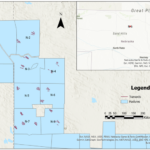
Field and remotely sensed observations were taken at Barta Brothers Ranch throughout the 2022 and 2023 grazing seasons. Ground sampling was carried out in three locations on the ranch: burned, unburned, and a neutral site formerly used to study biocomplexity in the system. In 2022, researchers detected an increase in the burned treatment's reflectance, likely arising from increased albedo affecting the surface energy balance. This team also found decreases in key energy absorption bands, likely resulting from the loss of standing biomass. These two observations may explain a possible surface cooling effect resulting from the use of prescribed fire. In 2023, remote sensing data was collected in Pastures N-2 through N-8, with transects shown in dune complexes (groupings of 4; dune top, interdunal, north slope, and south slope). Plant species data was collected in 1-m2 quadrats of two dune complexes.
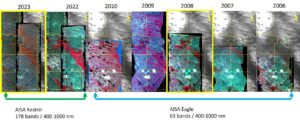
In 2023, work began using airborne hyperspectral images collected since 2006 overlaid onto a digital elevation model with pasture outlines. Images from 2006 to 2010 were collected for a grassland destabilization project (these treated areas can be seen in white dots which are more evident in the older images) while 2022 and 2023 imagery were planned to cover a larger area, including CAM fire and grazing treatments. Imagery outlined in yellow (2008 and 2023) had associated ground sampled plant species and hyperspectral data collected along transects on different dune topographic positions (dune top, interdunal north slope, and south slope) in the same summer.
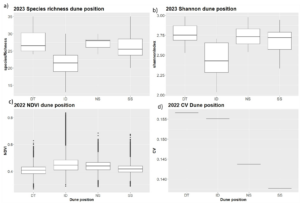
Preliminary results from these studies are shown in boxplots of a) species richness and b) Shannon diversity index derived from transect-level plant species data collected in 2023 along transects at four dune topographic positions (dune top [DT], interdunal [ID], north slope [NS], and south slope [SS]) and c) normalized difference vegetation index (NDVI) and d) spectral diversity (coefficient of variation-CV) derived from the 2022 imagery in Pastures N2 – N8.
From the plots, higher biodiversity may be associated with lower NDVI (greenness), potentially from variation of plant types rather than homogenous green vegetation. Panel d suggests higher variability of spectra for dune tops and interdunes possibly from high variation related to vegetation species, ground types (vegetation, soil, sand), or among transects in different complexes.
Social learning
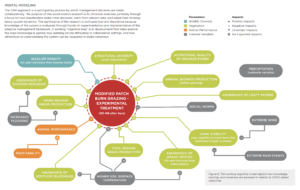
The CAM approach is a participatory process by which management decisions are made collaboratively. The purpose of this social science research is to chronicle exercises, primarily through a focus on how stakeholders make initial decisions, learn from relevant data, and adapt their thinking about system dynamics. In 2022, a working “cognitive map” was developed to explore the ways knowledge is gained, how learning can be stimulated in collaborative settings, and how differences in understanding the system can be navigated to build consensus. This working model will be revisited with the CAM stakeholders following the 2024 growing season.
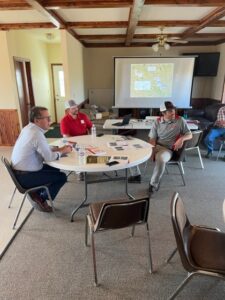
The stakeholders of the CAM Project were encouraged by the first two years of results and recommended a continuation of the patch-burn grazing management. These feelings of optimism were also shared by Congressman Adrian Smith (NE-3) who visited BBR in 2023. The third year of the CAM Project (2024) will target pasture N-8 for burning, followed once again by season-long grazing across all four pastures. This year’s prescribed burn presents a unique opportunity to address questions regarding eastern redcedar control, as this pasture has the highest density of trees in burn/grazed rotation. The preliminary results from the first two years of the CAM Project are working to confirm anecdotal observations on the ranch; however, more information is required to determine patch-burn grazing effects on livestock performance, plant production, ranch profitability, and eastern red cedar control. Monitoring of all variables will continue in 2024, along with additions of long-term landcover and eastern redcedar treatment effects.
Education
The CAM Project utilizes a tiered-approach to learning and education Through the adaptive management framework, we emphasize collaboration in our structured decision-making process to guide management of the experiment. This setting allows for group participation, enhanced learning outcomes through cognitive modeling, and provides a rich environment for the co-production of science. We also look to expertise from Nebraska's Extension Educators who possess a breadth and depth of practical experience alongside their innovative approach to collaboration and education in the agricultural community. Lastly, we rely on the outreach efforts from the entire University research team as individual members conduct field tours, consultations, presentations, author media articles, and host training and networking opportunities throughout the year. This diversified approach allows the CAM Project to have immediate relevance within the Sandhills region (focal point of study), but it also allows CAM to communicate and coordinate with stakeholders statewide on the implications of the CAM Project.
Project Activities
Educational & Outreach Activities
Participation Summary:
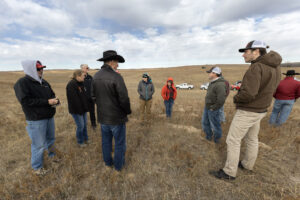
The first two years of the CAM Project at Barta Brothers Ranch were active with education and outreach. To summarize, these included regular CAM project team meetings, articles in University newsletters and regional media outlets, the establishment of a web presence for the Barta Brothers Ranch and the CAM Project, presentations to audiences of ranchers, natural resource managers, and researchers, and several on-site field exercises and tours. Consultations are being held with neighboring ranches to discuss CAM's implications and proactively manage eastern redcedar across the landscape. Researchers are also sharing preliminary findings with colleagues at national conferences, helping bolster the data collection and analysis efforts of the CAM Project Team. Cumulatively, we estimate that over 2,000 individuals engaged in grassland management or education have received information about the CAM Project at Barta Brothers Ranch.
CAM Project Team Meetings
The CAM Project Team (ranchers, natural resource managers, and researchers) began a regular cadence of meetings at the ranch (3-4 times per year). These meetings are a steady stream of CAM project updates, research design or analysis, and the selection and weighting of indicators to evaluate the outcomes. These team meetings also combine field tours to the pastures to inspect and discuss conditions firsthand. These meetings and associated exercises are critical to the structured decision-making process established in an adaptive management approach. These meetings result in approximately 600 hours of combined continuing education for the CAM Project Team.
Education
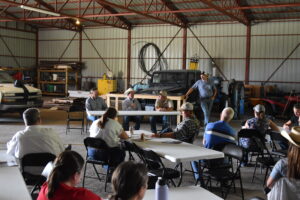
The University research team was active with both its education and outreach in years one and two of the CAM Project. Presentations were delivered to the Nebraska Grazing Conference, the Society of Range Management (national and Nebraska chapters), the Nebraska Cattlemen Association, Nebraska Grazing Lands Coalition, a University of Nebraska Agricultural Resilience Forum, Center for Grassland Studies Fall Seminar Series, and Nebraska's Sustainable Agriculture Society annual meeting.
These efforts were matched with tours, consultations, and other educational activities occurring in the Sandhills region. For example, CAM researchers led a group of area ranchers on a tour of the modified patch-burn grazing system at Barta Brothers Ranch during the grazing season. CAM researchers consulted with several ranching families on the successful use of prescribed burning in their management plan. CAM researchers also led an educational session with Nebraska's Extension Educators on the CAM project's objectives and how to get involved. A highlight in 2023 was the first open house held at Barta Brothers Ranch in over ten years. This event drew in 60 attendees, many of them neighboring ranchers.
Outreach
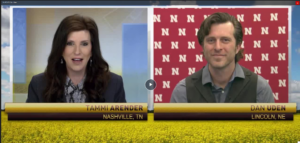 The establishment and revision of University webpages were important contributions in heightening the awareness of the CAM Project in Nebraska and beyond. This included new webpages for the Center for Resilience and an associated page about CAM as well as revisions to the Nebraska Extension website. CAM researchers produced ten web-based articles, three articles for University newsletters, one short-form podcast for statewide media distribution, and a nationally syndicated television interview with RFD-Tv. The team is currently developing a second standalone publication summarizing the CAM Project and years 1 and 2 results.
The establishment and revision of University webpages were important contributions in heightening the awareness of the CAM Project in Nebraska and beyond. This included new webpages for the Center for Resilience and an associated page about CAM as well as revisions to the Nebraska Extension website. CAM researchers produced ten web-based articles, three articles for University newsletters, one short-form podcast for statewide media distribution, and a nationally syndicated television interview with RFD-Tv. The team is currently developing a second standalone publication summarizing the CAM Project and years 1 and 2 results.
Learning Outcomes
- adaptive management
- patch burn grazing system
- ecosystem services
- management of tradeoffs